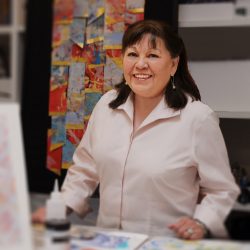One of Santa Fe’s newest galleries has garnered two distinguished contemporary artists for its homage to Indian Market: Ramona Sakiestewa and G. Peter Jemison have a show of new works opening today at Eight Modern.
“We are so excited we are just ecstatic,” Eight Modern co-owner Jaquelin Loyd said. Jemison is one of Eight Modern’s stable of artists and Sakiestewa agreed to join her friend of more than 30 years for this exhibition. Both artists are Native American, but as the show testifies, they long ago moved beyond categories. In face, Loyd noted, the Eight Modern exhibition specifically confronts issues of cross-cultural communications and interdisciplinary practice.
Sakiestewa is showing a set of woodblock prints she designed and collaborated on with a carver and a printer from Japan and then gave additional fabrication. Jemison’s contributions include his trademark paintings on paper bags and paper parasols, plus two acrylics on canvas and one on paper.
“Ramona Sakiestewa is a contemporary artist,” her Web site intro states, and is she ever. Of Hope ancestry, she is renowned for her tapestries and works on paper, her influence on New Mexico art policy and the designs of the new National Museum of the American Indian at the Smithsonian. Her work hangs in multiple museum, corporate and private collections.
Based in Santa Fe, she has been working lately on a series of woodblock prints that combine her respect for her ancestry with her disrespect, to put it bluntly, for most art criticism.
Specifically, she collaborated with Japanese master carver Shoichi Kitamura of Kyoto, who carved her design evoking the Hopi kachina Shalako Mana into woodblocks that were then meticulously printed by the master printer Sato. “We did it all by e-mail and FedEx,” Sakiestewa told the Journal. “It was amazing, and such a pleasure to collaborate with them.”
Sakiestewa then supplemented the prints with a collage-type addition of handwritten excerpts from Art in America, co-opted from critical reviews but stripped of meaning. Some are affixed upside-down to the print.
“I guess I’m interested in juxtaposing critical reviews with the art,” Sakiestewa said. “I always laugh at art historians and critics who don’t know how to make art, or even, how it is made, but they’re reviewing it according to what they think it should be rather than the content itself.
“The reviews I find interesting are the ones that other artists have written about an artist’s work. I guess I just think they know more about what they’re talking about.”
Having traveled and lived around the world, Sakiestewa is quite familiar with the plight of artists from any minority – gender, tribal or ethnic – trying to make art against the mainstream majority’s preconceptions of what that minority’s art “should” be. “That’s the battle for all artists, isn’t it?” she asked. “To do what you want to do.”
Breaking out of the “Indian artist” mold has not been as much of a struggle for Peter “Pete” Jemison. He simply never accepted the mold in the first place. A member of the Heron clan of the Seneca Nation, Jemison now manages a Seneca historic site in upper New York state. But like Sakiestewa, he has traveled and studied widely. Although his later work is concentrated more on acrylic paintings on canvas and paper, he became most widely known for his beautiful and sometimes whimsical paintings on paper bags and paper parasols. He explained to the Journal that he found universality in the bags.
“A number of years ago, I was living in Brooklyn and taking the subway into the city to work each day. One day I was sitting there and doodling on my lunch bag, and I realized that was what most of us had in common – we were all carrying a “bag” of some sort. Might be a lunch bag, might be a shopping bag, might be a briefcase or a knapsack, but everybody had a bag. I got to thinking about how our ancestors all had bags, too, from woven and textile bags to leather bags with elaborate beadwork. There is this whole history of some kind of containers for humans.
“So mostly on a whim I began producing painted bags and showing them with my other work. When the bags got mentioned first and most often in any reviews, I realized they were hitting some kind of nerve,” Jemison said.
He found a spray that will de-acidify the paper and stop the natural deterioration, although he acknowledged that the bags, like his parasols, are fragile. That, he said, is part of the appeal. Painting on the paper parasols began with a show called “Indian Humor.”
“At that time it was hard to find anything in this country that wasn’t ‘Made in Japan,’ so I took some parasols and painted them,” he said. “It was tongue-in-cheek, a way of taking something Japanese and putting Native American art on it.”
Jemison’s humor is often present in the paper work. Acknowledging the slapdash way many of us travel, he’s taken two paper shopping totes and painted them to be “Matching Luggage.”
His recent work has been landscapes of the gorgeous Seneca historic site he lives on. “It is a very varied and very beautiful terrain. My closeness to this landscape really became a part of what I wanted to paint. Probably in the last seven years my work has been focused on capturing the changes to that landscape during our four very distinct seasons. It’s about how I relate to Mother Earth and to the natural landscape.”
Jemison, who said he was lucky to receive basic training in almost all media, also has been producing videos on the site, and he’ll be bringing some to Eight Modern.
“That’s my nature, too- keeping myself interested,” he said. “I started showing my art at age 19,” the 62-year-old Jemison said. “The challenge is to keep myself working.

